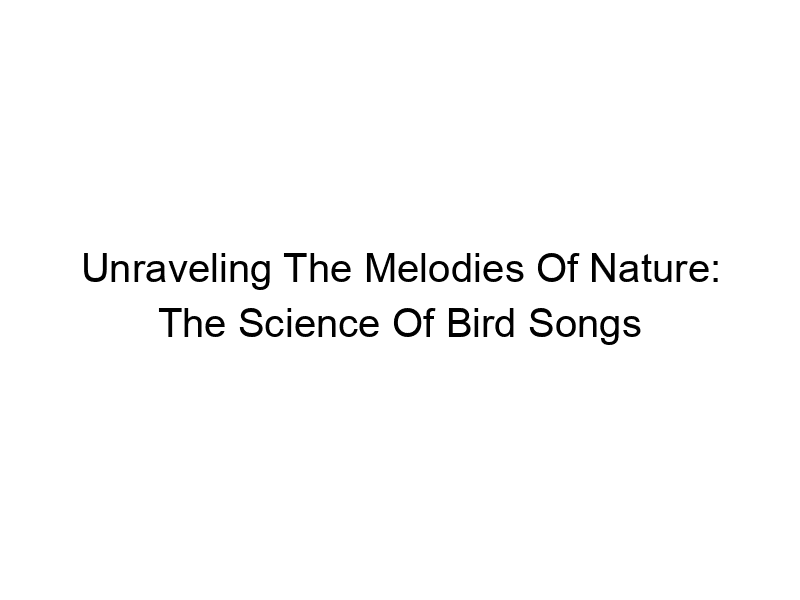Have you ever paused to listen to the symphony of birdsong on a spring morning? It’s more than just a pretty sound; it’s a complex communication system, a testament to the wonders of evolution. The Science of Bird Songs: How and Why Birds Sing is a fascinating field that explores this intricate world of avian vocalizations, from the mechanics of sound production to the intricate social and ecological functions of these melodies. In this comprehensive guide, we’ll delve into the anatomical mechanisms, the neurological processes, the diverse functions of birdsong, and the evolutionary pressures that have shaped this remarkable behavior. We’ll explore how birds learn their songs, how they use song to attract mates, defend territories, and even navigate. Get ready to discover the hidden secrets behind the chirps, tweets, and trills that fill our world.
The Anatomy of
Bird Song: How Birds Produce Sound
The Syrinx: The Bird’s Vocal Organ
Birds don’t sing with vocal cords like humans. Instead, they use a unique organ called the syrinx, located where the trachea splits into the lungs. The syrinx consists of membranes and muscles that vibrate to produce sound. Different species have syrinxes with varying structures, contributing to the vast diversity of bird songs. The intricate control of these muscles allows birds to produce complex melodies, often singing multiple notes simultaneously.
The Respiratory System’s Role
The respiratory system plays a crucial role in bird song production. Birds have a unique respiratory system with air sacs that extend throughout their bodies. This efficient system provides a constant flow of air over the syrinx, enabling prolonged singing. The pressure and flow of air are finely controlled, impacting the volume and pitch of the song.
The Neuroscience of Birdsong: Brain Mechanisms and Learning
Brain Regions Involved in Song Production
Several brain regions are dedicated to song production and learning in songbirds. The most crucial area is the HVC (higher vocal center), which plays a vital role in song control. Other key areas include the RA (robust nucleus of the arcopallium) and the Area X, which are essential for song learning and motor control. Damage to these regions can dramatically impact a bird’s ability to sing.
Song Learning: A Developmental Process
Many songbirds learn their songs during a critical period in their development. This learning involves listening to adult songs, memorizing them, and then practicing and refining their own vocalizations. The brain undergoes significant structural changes during this process, demonstrating the plasticity of the avian brain.
The Functions of Birdsong: Communication and Survival
Attracting Mates: The Song of Courtship
Birdsong is a crucial tool in mate attraction. Males often use elaborate songs to attract females, showcasing their fitness and genetic quality. The complexity and quality of a bird’s song can be a major factor in mate selection, influencing reproductive success. Females may prefer songs with specific characteristics, indicating a preference for certain genetic traits.
Territorial Defense: Claiming and Protecting Resources
Birds also use song to defend their territories. The song serves as an acoustic advertisement, warning other birds of their presence and deterring intruders from encroaching on their breeding grounds or food sources. Aggressive vocalizations are often used in territorial disputes, creating a vocal battle for dominance.
Maintaining Social Cohesion: Group Communication
In many species, birdsong is crucial for maintaining social cohesion within flocks or groups. Calls and songs coordinate movement, alarm calls warn of danger, and contact calls maintain proximity amongst group members.
The Evolution of Birdsong: Adaptive Significance and Diversity
Phylogenetic Relationships and Song Diversification
The evolution of birdsong is linked to the diversification of bird species. Different species have evolved unique songs, often reflecting their evolutionary history and ecological environment. Studies of bird song evolution often utilize phylogenetic analyses to understand the relationships between song characteristics and species’ evolutionary relationships.
Environmental Influences on Song Evolution
Environmental factors significantly impact the evolution of birdsong. Habitat structure, predation pressure, and the presence of competitors all influence the selection pressures shaping song characteristics. For instance, birds in noisy environments may evolve songs with louder or more distinctive features to be heard above the background noise.
Sexual Selection and the Evolution of Complex Songs
Sexual selection plays a critical role in driving the evolution of complex birdsongs. Females may prefer males with elaborate songs, leading to the evolution of increasingly complex vocalizations over time. This process can result in remarkable diversity in song structures across different species.
Learning and Memory in Birdsong: How Birds Master Their Repertoire
The Role of Auditory Feedback
Auditory feedback is essential for song learning. Young birds constantly monitor and adjust their vocalizations based on the sounds they hear. This process involves comparing their own vocalizations to the songs of adult birds, fine-tuning their songs to match the model.
Neural Mechanisms of Song Memorization
The brain plays a crucial role in memorizing and reproducing songs. Specific brain regions are involved in the encoding and storage of song templates, allowing birds to retrieve and reproduce these melodies later in life.
Individual Variation in Song Learning
Not all birds learn songs with equal ease. Individual differences in learning ability and environmental conditions influence the complexity and accuracy of their song repertoire. These individual variations contribute to the diversity of songs within a species.
Individual Recognition and Birdsong: Identifying Neighbors and Rivals
Variations in Song Dialects
Different populations of the same species often have distinct song dialects. These variations are learned and can be used to identify birds from different groups. This ability to recognize individuals within their group is essential for social interactions and territorial defense.
The Use of Song in Individual Recognition
Birds use subtle variations in their songs to recognize individuals. These subtle changes in pitch, timing, and structure act as acoustic signatures, allowing birds to identify neighbors, rivals, and potential mates. This is crucial for establishing social hierarchies and maintaining social order within a community.
Ecological Impacts of Birdsong: How Songs Shape Ecosystems
Communication with other species
Birdsong isn’t just for birds; it also plays a role in communication with other species. For instance, certain bird calls might warn other animals of impending predators. Conversely, predators might use bird calls to locate their prey. This interspecies communication highlights the complex interplay within an ecosystem.
Impact of habitat fragmentation on birdsong
Habitat loss and fragmentation can have profound consequences for birdsong. Isolation of bird populations leads to reduced gene flow and can result in the divergence of song dialects. This loss of diversity can also impact the ability of birds to effectively communicate and reproduce.
The role of birdsong in biodiversity
The diversity of birdsong itself contributes significantly to overall ecosystem biodiversity. The variety of sounds produced by different birds creates a rich acoustic landscape, reflecting the richness of species within a habitat. Monitoring the diversity of birdsong can be a powerful tool in assessing ecosystem health.
The Technology of Birdsong Research: Recording and Analyzing Avian Melodies
Advanced Recording Techniques
Scientists use sophisticated recording equipment to capture birdsong, from high-quality microphones to specialized sound recorders. These devices capture the full spectrum of avian sounds, allowing researchers to analyze the subtle variations in pitch, frequency, and timing.
Data Analysis Methods for Birdsong
Analyzing birdsong requires specialized software and techniques. Sophisticated software can measure various acoustic parameters of the song, such as frequency, amplitude, and duration. This data can be used to compare songs from different individuals, populations, or species.
Applications of Birdsong Research: Conservation and Monitoring
Understanding birdsong is essential for conservation efforts. By monitoring the diversity and characteristics of birdsong, scientists can assess the health of bird populations and identify species at risk. This information is crucial for implementing effective conservation strategies.
The Future of Birdsong Research: Emerging Trends and Discoveries
The Influence of Climate Change on Birdsong
Climate change is affecting the timing of bird breeding and migration, which in turn can impact birdsong. Changing environmental conditions might alter the acoustic environment, influencing song characteristics and communication effectiveness.
The use of Artificial Intelligence in Birdsong Analysis
Artificial intelligence (AI) is revolutionizing birdsong research. AI algorithms can analyze large datasets of bird songs more efficiently than humans, identifying patterns and trends that may be missed by manual analysis.
Conservation Implications of Birdsong Research
Birdsong research plays a critical role in conservation biology. Understanding how birds use songs to communicate, attract mates, and defend territories is essential for implementing effective conservation strategies.
Frequently Asked Questions
What is the purpose of birdsong?
Birdsong serves a multitude of purposes, including attracting mates, defending territories, maintaining social cohesion, and warning of danger. The specific function often depends on the species and context.
How do birds learn their songs?
Many songbirds learn their songs during a critical period in their development. They learn by listening to and memorizing adult songs, and then practicing and refining their own vocalizations. This process involves complex neural mechanisms and auditory feedback.
What are the anatomical structures involved in birdsong?
Birds produce sound using the syrinx, a unique vocal organ located where the trachea branches into the lungs. The respiratory system, with its air sacs, also plays a crucial role in providing the airflow needed for song production.
How does birdsong contribute to biodiversity?
The diversity of birdsong reflects the overall biodiversity of an ecosystem. The variety of sounds produced by different bird species contributes to a rich acoustic landscape. Monitoring birdsong diversity can be a valuable tool for assessing the health of ecosystems.
How is birdsong research being used in conservation?
Birdsong research is crucial for conservation efforts. By analyzing changes in song diversity and characteristics, scientists can identify species at risk, track population trends, and assess the impact of environmental changes.
What are some of the challenges faced in birdsong research?
Challenges include the difficulty of recording and analyzing complex sounds, identifying individual birds in large populations, and the need for extensive field work. Technological advancements and the application of AI are helping to address these challenges.
Final Thoughts
The science of birdsong offers a fascinating glimpse into the intricate world of avian communication. From the mechanics of sound production to the complex social and ecological functions of these melodies, birdsong represents a remarkable example of natural selection and adaptation. Understanding the science behind bird songs is not only intellectually stimulating but also crucial for conservation efforts. By recognizing the importance of these acoustic landscapes and the roles birdsong plays in maintaining biodiversity, we can work to protect these captivating creatures and their vital contributions to our ecosystems. This detailed exploration into the world of bird song highlights the intricate interplay between anatomy, neurobiology, behavior, and ecology. By delving deeper into this field, we can unlock a greater understanding of the natural world around us. Let’s continue to appreciate and protect the diverse and captivating melodies of nature.




